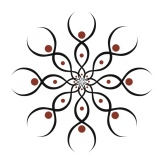The deodorant dilemma.
Are you anything like me? I am very conscious of what I eat, read labels on cosmetics and household cleaners. I try to live as chemical free as I can but when it comes to my deodorant I will slap on anything that works regardless of what the label says. I will not risk smelling bad even though I know how potentially harmful antiperspirants can be.
In the past I had tried many brands of natural deodorants but always wound up using some version of Secret. The natural brands could not hold up to my life style, I work closely with clients all day and just cannot risk smelling bad. For a brief time I rotated the natural deodorants in hopes that they keep working. I would use the crystal for about 2 weeks, then start adding lavender essential oils to try to keep it working, then use something totally different for the next week. As you can see this is very time consuming, frustrating and expensive.
While researching natural deodorants for the The new Luv Your Boobs website myself and my business partner Jenny Beech learned 2 things:
First- Read labels.
There are certain chemicals in deodorants that you want to avoid (they are listed below) also I am suspect whether there is full disclosure on what is put on labels. Most commercial deodorants are full of “fillers”, these are added to make the deodorant easier to pour into a container therefore easier to use and cheaper and quicker to make.
Second- it has to work.
Natural does not mean effective. We failed in finding a natural deodorant that we both thought was effective and could stand up to a regular day at work. After much frustration we Googled “recipe for natural deodorant” took the first recipe that popped up, altered it slightly based on comments and magically made our first deodorant. After using it for several weeks and it kept working I started to tell everyone. Gave the recipe away over and over, gave away samples and really encouraged my clients to make it at home. They all loved it but said “I won’t make it myself, can you just make it and I’ll buy it from you?”
Silk deodorant comes to life!
So we did! Luv Your Boobs never intended to make deodorant, we started purely to educate women on breast health and make bras. It was a little like falling down the rabbit hole and now I suddenly have 200 pounds of baking soda and corn starch in my dining room and we have a “cooking” session once a month.


The bad news
Listed below are the top controversial ingredients in your commercial deodorant:
Aluminum -active ingredient in antipersperants to stop sweat glands from producing sweat. Linked to Alzheimer’s?
Parabens -a common preservative that mimics estrogen in the body. Elevated estrogen levels are linked to increased risk for breast cancer.
Propyolene glycol – used to stop products from drying out, was originally created as an anti-freeze- NEED I SAY MORE!
TEA and DEA (triethanolamine and diethanolamine). Once absorbed into our body causes allergic reactions and can lead to liver and kidney damage. Both are known carcinogens.
For more information on what each of the ingredients in your current deodorant are and how they affect your body visit Skin Deep or Campaign for Safe Cosmetics.
Why should we worry about putting these chemicals on our skin?
Let’s start with where we apply deodorant. Under the arm!
The axilla (armpit area) has many lymph nodes that are directly linked to breast tissue. Our skin is permeable so what we put on our skin can absorb into our body tissue. Taxing the axillary lymph nodes with external toxins can cause a congestion of lymphatic drainage and a stagnation of toxins in the breast tissue.

50% of breast cancer is found in the upper outer quadrant of the breast, closest to where you place deodorant. So why risk it?
The benefits of SILK deodorant.
Our product is made from 3 simple ingredients that you can find in your kitchen: Virgin coconut oil, baking soda and corn starch. All edible, all natural and you can pronounce all of them.
We can proudly say our natural deodorant was never tested on any animals, unless you count all our friends who offered up their armpits to help bring it to life.
How to use our deodorant.
KEEP IT IN THE FRIDGE. Beware virgin coconut oil is one of the main ingredients and will melt at temperaters above 36 degrees celsius (97 degrees fahrenheit). If this happens just sit upright in cool place and the deodorant will reset and work perfectly fine once hardened.
To be honest our deodorant like other natural deodorants can be a little finicky until you get used to it. The key to ours is use very little – LIGHTLY rub on, only a few swipes is needed. If you press too hard or use too much you will risk getting it on your clothing (it will brush off easily leaving no trace) or crumble. If it crumbles just gently push back into the container, the heat of your hand will remould the product. If applied properly our deodorant can last up to six months.
Finickiness is a small price to pay for peace of mind! Know what goes on your skin, goes into your body and feel better knowing.
I hope you enjoy our “Silk” deodorant.
I would love to hear your feedback.





